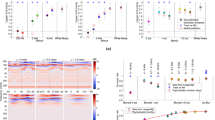Abstract
DISTORTIONS of perception following prolonged exposure to an unvarying sensory stimulus have been observed since at least the third century BC1. The motion after-effect is a familiar experience2 in which, after a few minutes of viewing objects moving in a single direction, a stationary object appears to move in the opposite direction. Similar after-effects have been observed for many visual stimuli, including tilted lines, colours, stereoscopic depth, curvature, spatial frequency, contrast, rotation and motion in depth3–9. In contrast to the rich variety of visual after-effects reported since the 1960s, reports of analogous auditory adaptation effects only appeared in the 1970s10–12, but have continued since then13,14. Some effects of sound source spatial movement perception after adaptation to a spatially moving sound source have been reported15. Here we report an auditory perceptual after-effect analogous to the visual motion after-effect, which is caused by adaptation to auditory spectral (frequency) motion. After a few minutes of listening to a simple spectral pattern moving upwards or downwards in frequency space, the same pattern sounds as though it is drifting in the opposite direction when it is stationary. The effect shows binaural transfer, implying that it is generated at the level after binaural interaction. After-effects produced by the motion of spectral peaks are independent of those produced by spectral notches, suggesting separate processing channels for spectral peaks and notches.
This is a preview of subscription content, access via your institution
Access options
Subscribe to this journal
Receive 51 print issues and online access
$199.00 per year
only $3.90 per issue
Buy this article
- Purchase on Springer Link
- Instant access to full article PDF
Prices may be subject to local taxes which are calculated during checkout
Similar content being viewed by others
References
Aristotle Parva Naturalia.
Wohlgemuth, A. Brit. J. Psychol. 1, 1–117 (1911).
Barlow, H. B. & Hill, R. M. Nature 200, 1345–1347 (1963).
Sekuler, R. W. & Ganz, L. Science 139, 419–420 (1963).
Anstis, S. M. Science 155, 710–712 (1967).
Mayhew, J. E. W. & Anstis, S. M. Percept. Psychophys. 12, 77–85 (1972).
Walker, J. T. Psychonom. Sci. 28, 333–335 (1972).
Potts, M. J. & Harris, J. P. Vision Res. 15, 1225–1230 (1975).
Favreau, O. E. Vision Res. 16, 181–186 (1976).
Kay, R. H. & Matthews, D. R. J. Physiol., Lond. 225, 657–677 (1972).
Regan, D. & Tansley, B. W. J. Acoust. Soc. Am. 65, 1249–1257 (1979).
Gardner, R. B. & Wilson, J. P. J. Acoust. Soc. Am. 66, 704–709 (1979).
Kay, R. H. Physiol. Rev. 62, 894–975 (1982).
Wilson, J. P., Crampin, E. J. & Cann, N. Brit. J. Audiol. 26, 188 (1992).
Grantham, D. W. Percept. Psychophys. 45, 129–136 (1989).
Finney, D. J. Probit Analysis 3rd edn (Cambridge Univ. Press, 1971).
Blauert, J. Spatial Hearing (MIT Press, Cambridge, MA, 1983).
Bloom, P. J. J. Audio. Eng. Soc. 25, 560–565 (1977).
Butler, R. A. & Helwig, C. C. Am. J. Otolarybgol. 4, 165–173 (1983).
Moore, B. C. J., Oldfield, S. R. & Dooley, G. J. J. Acoust. Soc. Am. 85, 820–836 (1989).
Mendelson, J. R. & Cynader, M. S. Brain Res. 327, 331–335 (1985).
Green, G. G. R., Heffer, R. J. S. & Ross, D. A. J. Physiol., Lond. 260, 49P (1976).
Author information
Authors and Affiliations
Rights and permissions
About this article
Cite this article
Shu, Z., Swindale, N. & Cynader, M. Spectral motion produces an auditory after-effect. Nature 364, 721–723 (1993). https://doi.org/10.1038/364721a0
Received:
Accepted:
Issue Date:
DOI: https://doi.org/10.1038/364721a0
This article is cited by
-
Spatial hearing training in virtual reality with simulated asymmetric hearing loss
Scientific Reports (2024)
-
Congruent audio-visual stimulation during adaptation modulates the subsequently experienced visual motion aftereffect
Scientific Reports (2019)
-
Prior context in audition informs binding and shapes simple features
Nature Communications (2017)
-
The effect of neural adaptation on population coding accuracy
Journal of Computational Neuroscience (2012)
-
Hearing visual motion in depth
Nature (2002)
Comments
By submitting a comment you agree to abide by our Terms and Community Guidelines. If you find something abusive or that does not comply with our terms or guidelines please flag it as inappropriate.



